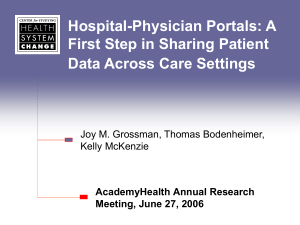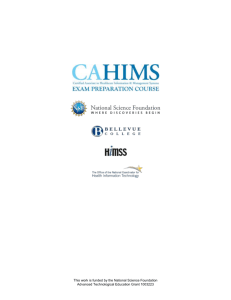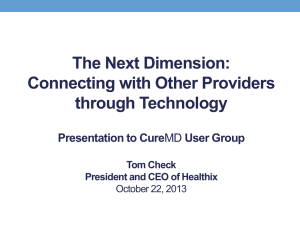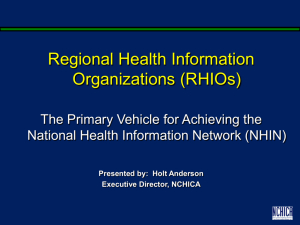Regional Health Information Organizations: Progress and Challenges Julia Adler-Milstein Academy Health
advertisement
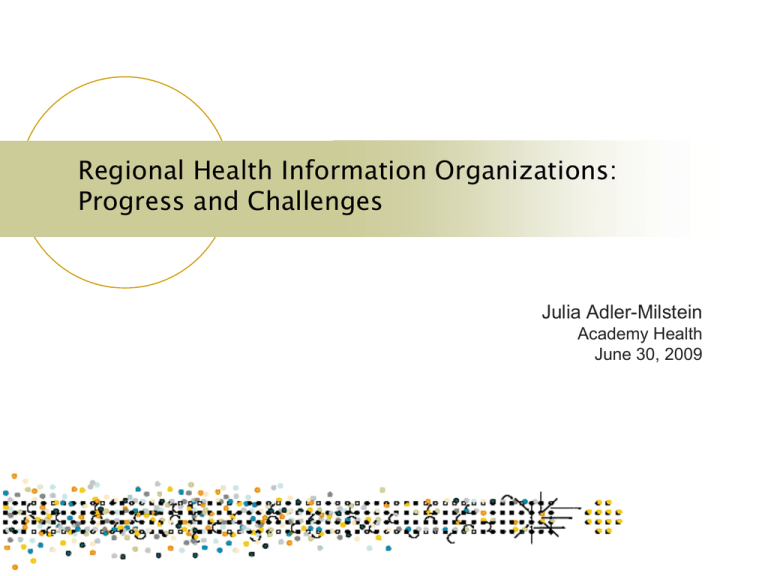
Regional Health Information Organizations: Progress and Challenges Julia Adler-Milstein Academy Health June 30, 2009 Overview 30 billion transactions per year Context Regional Health Information Organizations (RHIOs) are: “organizations that facilitate electronic HIE between independent entities in a defined geographic region to improve health and care” If RHIOs are to serve as the foundation for nationwide health information exchange, it is critical to understand: progress successful models obstacles and challenges Today’s Presentation RHIOs Census I Summarize results of first RHIOs census conducted in early 2007 RHIOs Census II Describe in detail follow-up census conducted in mid-2008 RHIO Success Factors Summarize results of multivariate analyses using census II data RHIO Participation among Hospitals Describe in detail study looking at RHIO penetration among hospitals and characteristics that distinguish hospitals that participate in RHIOs from non-participants RHIOs Census I RHIOs Census I RHIOs Census II RHIO Success Factors RHIO Participation among Hospitals Census of US RHIOs; conducted in early 2007 Key Findings High failure rate Few operational Narrow scope of activities Uncertain business model Open Questions Premature assessment of viability? RHIO growth over time? Adler-Milstein et al, 2007 RHIOs Census II RHIOs Census I RHIOs Census II RHIO Success Factors RHIO Participation among Hospitals Has the number of RHIOs that are operational increased in the 17 months since our last survey? What types of entities participate in RHIOs and what types of data are they exchanging? How many RHIOs are self-sustaining and how optimistic are the others that they will eventually become so? What are the self-perceived barriers to successful, selfsustaining RHIOs? Have RHIOs that were operational in our 2007 survey grown over time? Methods RHIOs Census I RHIOs Census II RHIO Success Factors RHIO Participation among Hospitals Identification of RHIOs eHealth Initiative Directory: 102 from initial survey plus 105 new to directory as of May 2008 Survey Development 2007 version; new financial questions and questions about obstacles to development Cognitive testing with small subset of RHIOs Survey Administration June-August 2008 Web-based Results RHIOs Census I RHIOs Census II RHIO Success Factors RHIO Participation among Hospitals 207 Organizations Identified 36 Unable to Determine Status 40 Never Pursued HIE 131 Were/Are Pursuing HIE 28 Operational as of 1/1/07 As of 6/1/08 23 Operational 3 Stalled 14 Did Not Respond to 2007 Survey 41 Planning as of 1/1/07 2 No Longer Pursuing HIE 6 Operational 16 Planning 55 Operational as of 6/1/08 19 No Longer Pursuing HIE 6 Operational 42 Planning as of 6/1/08 5 Planning 48 Not Surveyed in 2007 3 No Longer Pursuing HIE 34 No Longer Pursuing HIE as of 6/1/08 20 Operational 18 Planning 10 No Longer Pursuing HIE Results RHIOs Census I RHIOs Census II RHIO Success Factors RHIO Participation among Hospitals Types of Entities Providing and Receiving/Viewing Data (n=44) Data Providers Data Receivers/Viewers 100% 86% 84% Percent of RHIOs 80% 73% 70% 68% 57% 60% 39% 40% 34% 32% 34%34% 34% 25% 20% 20% 18% 11% 0% Hospital Ambulatory MD/Clinic Lab Imaging Center Pharmacy Public Health Payer (public and Dept private) PBM Results RHIOs Census I RHIOs Census II RHIO Success Factors RHIO Participation among Hospitals Types of Clinical Data Exchanged (n=44) 90% 84% 80% 70% Percent of RHIOs 70% 66% 64% 60% 50% 40% 30% 20% 14% 10% 0% Test results Inpatient data Medication history Outpatient data Public health reports Results RHIOs Census I RHIOs Census II RHIO Success Factors RHIO Participation among Hospitals Forms of Support After Initiation of Clinical Data Exchange (n=44) Results Covering expenses* Months to viability RHIOs Census I RHIOs Census II RHIO Success Factors RHIO Participation among Hospitals Planning Operational 11% 41% 22 months 25 months * Covering operating expenses with revenue from participating entities Results RHIOs Census I RHIOs Census II RHIO Success Factors RHIO Participation among Hospitals Likelihood that RHIO will break-even with revenue from participating entities among those that have not already done so 70% 61% 60% Percent of RHIOs 50% 44% 40% Planning 28% 30% 22% Operational 20% 20% 13% 8% 10% 4% 0% Definitely or Probably Not Maybe Probably or Definitely Will Don’t Know n=23 planning; n=25 operational Results RHIOs Census I RHIOs Census II RHIO Success Factors RHIO Participation among Hospitals Barriers to Development n=27 planning; n=44 operational Results--Longitudinal RHIOs Census I RHIOs Census II RHIO Success Factors RHIO Participation among Hospitals 41 Planning as of 1/1/07 Few RHIOs planning in 2007 became operational in 2008 6 Operational 16 Planning Among 20 operational RHIOs in 2007: 17 still operational No significant growth in breadth of activities Some changes in sources of support 19 No Longer Pursuing HIE Summary of Key Findings RHIOs Census I RHIOs Census II RHIO Success Factors RHIO Participation among Hospitals Growing number of operational RHIOs For every RHIO that became operational, more than three “failed” Focus on exchange of tests results and medication histories; no evidence that RHIOs expand breadth of activities over time Minority of operational RHIOs appear financially stable and remaining RHIOs very pessimistic Policy Implications RHIOs Census I RHIOs Census II RHIO Success Factors RHIO Participation among Hospitals Disconnect between expectations/beliefs of RHIO progress and the reality Progress towards nationwide HIE slow and significant uncertainty as to whether RHIOs will serve as the foundation Lack of rigorous evaluations is one likely cause However, paving the road for RHIO success requires addressing a wide array of barriers Limitations RHIOs Census I RHIOs Census II RHIO Success Factors RHIO Participation among Hospitals Incomplete set of RHIOs RHIOs classified as defunct may still be operating Growth measured by breadth rather than depth Self-reported data RHIOs Success Factors – Summary Results RHIOs Census I RHIOs Census II RHIO Success Factors RHIO Participation among Hospitals Operational Broad participants Narrow types of data Financially Viable Early support from participants Ambulatory providers as data receiver Hospitals as data receiver Characteristics of Hospitals that Participate in RHIOs RHIOs Census I RHIOs Census II RHIO Success Factors RHIO Participation among Hospitals RHIO success dependent on stakeholder willingness to share data Hospitals and ambulatory providers key stakeholder groups Conflicting incentives for stakeholder participation (Grossman et al., 2008) Research Questions: To what extent are hospitals participating in RHIOs? What differentiates hospitals that participate in RHIOs from those that do not? Methods RHIOs Census I RHIOs Census II RHIO Success Factors RHIO Participation among Hospitals American Hospital Association Annual Survey: IT Supplement Sent to all acute care general medical and surgical member hospitals March 2008-September 2008 63.1% response rate; 3,049 hospitals (2,952 US non-federal) HIE Survey Questions RHIO participation Type of data exchanged with unaffiliated hospitals and providers Descriptive Statistics – RHIO penetration (hospital and HRR level) Bivariate and Multivariate Analyses – Characteristics of RHIO Participants vs. Non-Participants A priori list of characteristics: size, profit status, IT infrastructure, other technology, system affiliation, teaching status, and percent Medicaid Results – RHIO Penetration RHIOs Census I RHIOs Census II RHIO Success Factors RHIO Participation among Hospitals 269 hospitals (9.1%) reported participating in a RHIO and exchanging at least 1 type of data with an unaffiliated entity 134 of 304 (44%) Health Referral Regions (HRRs) had at least 1 hospital participating in a RHIO Median number of participating hospitals per HRR: 1 Median percent of participating hospitals per HRR: 14% HRRs with highest RHIO participation (>1/3 hospitals) and at least the median number of hospitals responding to survey per HRR (>=7) Asheville, NC Spokane, WA Cincinnati, OH Albany, NY Indianapolis, IN 86% (6 of 7 responding hospitals) 50% (13 of 26) 46% (6 of 13) 40% (6 of 15) 39% (13 of 33) Results – Characteristics of Participating Hospitals Hospital Size Small (N=1,402) Medium (N=1,262) Large (N=288) Ownership Private, For-profit (N=422) Private, Non-profit (N=1,832) Government, Non-profit (N=698) Teaching Status Major Teaching (N=223) Minor Teaching (N=482) Non-teaching (N=2,247) Presence of Cardiac ICU (N=964) No CICU (N=1,799) System Affiliated (N=1,260) Not System Affiliated (N=1,692) Percentage of Medicaid Patients First Quartile Second Quartile Third Quartile Fourth Quartile IT Infrastructure Have No EHR (N= 2,685) Have Basic EHR* (N=221) Have Comprehensive EHR (N=46) Participates and shares data N=269 (9.1%) Percent 8 9 13 4 11 8 16 10 8 11 9 10 9 RHIOs Census I RHIOs Census II RHIO Success Factors RHIO Participation among Hospitals P-Value 0.030 <0.001 <0.001 0.040 0.24 9 10 10 8 0.73 8 19 20 <0.001 Results – Characteristics of Participating Hospitals Hospital Size Ownership Teaching Status Other Technology System Affiliation Medicaid Percentage IT Infrastructure Small (6-99 beds) Medium (100-399) Large (more than 400) Private, non-profit Private, for-profit Government, Non-profit Not teaching Minor Teaching Major Teaching Without Cardiac ICU With Cardiac ICU Part of a System Not Part of a System Quartiles 1-3 Highest Quartile No EHR Basic EHR Advanced EHR RHIOs Census I RHIOs Census II RHIO Success Factors RHIO Participation among Hospitals Adjusted Performance 95% Confidence Odds Ratio Interval Reference 1.01 [0.70 - 1.45] 0.92 [0.49 - 1.72] Reference 0.37 [0.19 - 0.70] 0.76 [0.53 - 1.08] Reference 1.08 [0.76 - 1.61] 1.91 [1.06 - 3.45] Reference 0.91 [0.67 - 1.24] Reference 0.88 [0.67 - 1.16] Reference 0.85 [0.61 - 1.18] Reference 2.47 [1.69 – 3.61] 2.51 [1.13 – 5.59] P-Value 0.94 0.005 0.087 0.57 0.38 0.33 <0.001 Summary of Key Findings RHIOs Census I RHIOs Census II RHIO Success Factors RHIO Participation among Hospitals RHIO penetration among hospitals is low Few hospitals actively participating in data exchange via RHIOs Less than half of HRRs have at least one participating hospitals Within HRRs with RHIOs, majority of hospitals do not participate Hospitals that participate in RHIOs differ from those that do not along two key dimensions More likely to be not-for-profit More likely to have advanced IT infrastructure Policy Implications RHIOs Census I RHIOs Census II RHIO Success Factors RHIO Participation among Hospitals Current efforts to engage hospitals in health information exchange have not had broad penetration Low rates of RHIO participation among for-profit hospitals suggest that competition and fear of loss of market share may be holding them back Incentives are likely needed to garner greater enthusiasm to actively exchange clinical data with unaffiliated providers Greater adoption and use of HIT are likely to further spur participation as hospitals realize greater gains from availability of electronic data Thank You! Julia Adler-Milstein jadlermilstein@hbs.edu
